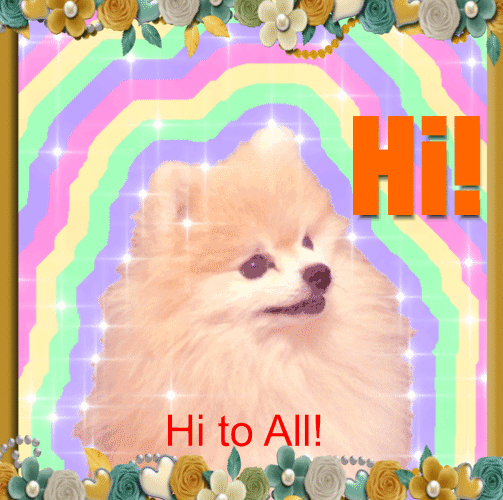What Is Hi In Spanish - Your Essential Guide
Learning to connect with people in a new language often begins with a simple hello, a friendly gesture that bridges gaps and brings folks closer together. When you start to pick up Spanish, knowing how to offer a greeting, to just say "hi," can feel like finding a key to a new place. It is that initial spark, a way to show you are ready to engage, and it really does make a difference in how others receive you. For many who are just starting out, or even those coming back to refresh their language abilities, getting this basic part down feels very rewarding.
It's true that saying hello in Spanish might seem like a small thing, yet, it carries a lot of weight in everyday interactions. A well-chosen greeting can set the tone for any conversation, making it feel more natural and welcoming. People often feel a sense of accomplishment when they can greet someone properly, as it shows a certain respect for the culture and the person they are speaking with. It's almost like stepping onto the first level of a truly interesting game, where each new piece of language you gather helps you move forward.
This guide is here to help you get a solid grip on how to say "hi" in Spanish, making sure you feel comfortable and ready for many different situations. We'll look at the simplest way to start a conversation, explore how greetings change depending on the time of day, and even discuss how your choice of words can shift based on who you are talking to. It's all about picking up those useful phrases that help you make a good first impression, whether you are just starting out or simply looking to polish up your conversational tools.
Table of Contents
- What is Hi in Spanish - The Simple Start
- Why is "Hola" So Common for What is Hi in Spanish?
- How Do You Say Hi in Spanish at Different Times?
- What is Hi in Spanish When Context Matters?
- Are There Many Ways to Say Hi in Spanish?
- How to Pronounce "Hola" for What is Hi in Spanish?
- Beyond "Hola" - Other Ways to Greet in Spanish
- What is Hi in Spanish - Cultural Pointers
What is Hi in Spanish - The Simple Start
When you are looking to say "hi" in Spanish, the word you will hear most often, and the one that is quite useful to know, is "hola." This word serves as a very straightforward way to greet someone, a basic building block for any chat you might have. It's the one that many people pick up first, and for good reason, too. It acts as a general purpose greeting, something you can use in nearly any setting without feeling out of place. It is really a go-to choice for almost any situation where you want to acknowledge someone's presence.
Think of "hola" as your main tool for saying hello, a word that fits in just about anywhere. It does not carry a strong sense of being overly formal, nor does it sound overly casual, which makes it a very safe bet. This means you can use it when meeting someone for the first time, when bumping into an old acquaintance, or even when just passing someone on the street. It is the sort of word that feels natural to use, and it's quite simple to remember, which is a big help for anyone getting started with the language. So, if you are ever wondering how to begin a conversation, "hola" is almost always the answer you are looking for.
Picking up "hola" as your initial greeting is a really smart move, as a matter of fact. It gives you a solid foundation, a phrase you can rely on while you begin to explore more ways to speak with people. It is a word that instantly lets others know you are trying to connect, and that effort is often very much appreciated. This basic hello is the starting point for many conversations, allowing you to move on to other things you might want to say. It is, in a way, the universal key for opening up communication in Spanish, and it is a phrase you will use often.
Why is "Hola" So Common for What is Hi in Spanish?
The reason "hola" pops up so frequently when discussing what is "hi" in Spanish comes down to its sheer flexibility. It's a word that does not box you in; it works well across a very wide range of social settings. You do not have to worry about whether it is too polite for a casual chat with friends or too relaxed for a meeting with someone you respect. This makes it a truly versatile option, something you can pull out in nearly any circumstance and feel quite good about using it. It is, basically, the word that fits.
Many greetings in different languages have specific rules about when and where they can be used, but "hola" is different. It sits comfortably in the middle, avoiding the extremes of being overly stiff or too informal. This means that whether you are talking to a child, a shopkeeper, a new friend, or someone much older than you, "hola" is a perfectly acceptable choice. It is a reliable friend in your language toolkit, always there to help you start things off on the right foot. You know, it is just a very dependable word.
The ease of use and broad acceptance of "hola" are what make it such a central part of learning how to greet people in Spanish. It is not just a word; it is a gateway to further conversation, a sign that you are ready to engage. Because it is so widely understood and used, it removes a lot of the guesswork that can come with learning a new language. This word, in some respects, simplifies the whole process of beginning an interaction, letting you focus more on what you want to say next rather than worrying about your initial greeting. It is really quite helpful.
How Do You Say Hi in Spanish at Different Times?
While "hola" is a wonderful general greeting, Spanish also offers ways to say "hi" that acknowledge the time of day, adding a touch of thoughtfulness to your words. These time-specific greetings are very common and show a nice awareness of the moment. They are often used right alongside "hola" or sometimes even on their own, depending on the flow of the conversation. Knowing these can really make your greetings feel more natural and connected to the time you are speaking. It is a simple way to make your communication a little richer.
For instance, when the sun is coming up and it is still morning, you would typically use "buenos días." This phrase translates to "good days" and is used from the very start of the day until around noon or early afternoon. It is a very common and polite way to say hello during these hours. Then, as the day moves into the afternoon, roughly from noon until sunset, you would switch to "buenas tardes." This means "good afternoons" and is the appropriate greeting for that part of the day. It is quite simple to remember, really, just a change based on the clock.
Later on, once the sun has set and evening arrives, or when it is nighttime, the phrase you will want to use is "buenas noches." This translates to "good nights" and serves both as a greeting and as a way to say goodbye in the evening. It is often used when you meet someone for an evening gathering or when you are leaving for the night. So, in a way, these greetings are like little timestamps on your conversations, showing that you are aware of the time. They are very much a part of everyday Spanish conversation, and people use them all the time.
What is Hi in Spanish When Context Matters?
When thinking about what is "hi" in Spanish, it is important to remember that the setting and the person you are talking to can really shape your choice of words. Spanish has different ways of speaking that depend on how close you are to someone or how much respect you need to show. This idea of formal versus informal language is a pretty big part of the language, and it affects how you greet people too. It is an extra little thing you will want to keep in mind, as it is quite important for smooth interactions.
For example, if you are speaking with someone older than you, someone in a position of authority, or someone you have just met in a more professional setting, you will generally want to lean towards more formal ways of speaking. This shows respect and a certain distance. On the other hand, if you are chatting with a close friend, a family member, or someone your own age in a relaxed setting, you can typically use more informal language. This creates a sense of closeness and comfort. It is almost like choosing the right outfit for a particular occasion, you know?
This distinction means that while "hola" works in most situations, adding other phrases can really fine-tune your greeting. For instance, asking "How are you?" can be done in a formal or informal way. Knowing which one to pick shows that you understand the social rules, and people really do appreciate that. It is not just about saying the words; it is about choosing the right tone for the situation. So, paying attention to the context makes your greetings feel more natural and appropriate, which is very much a good thing for anyone learning the language.
Are There Many Ways to Say Hi in Spanish?
You might already know that "hola" is the most common way to say "hi" in Spanish, but it is just the beginning of a truly rich collection of greetings. There are, in fact, many, many more ways to acknowledge someone in Spanish, ranging from very traditional expressions to more relaxed, everyday chat. It is like having a whole toolbox of greetings, each one useful for a slightly different kind of interaction. This variety means you can pick just the right words for almost any social moment.
Some people say there are over 25 different ways to say hello, while others suggest there might be more than 76 unique and creative expressions. This really goes to show how much flexibility there is in the language when it comes to starting a conversation. You can find ways to greet people that are quite formal, fitting for a business meeting or an older person, and then there are very casual ways, perfect for catching up with friends. It is quite interesting how many options you have, really.
These various greetings also include slang terms and very polite phrases, giving you a full spectrum of choices. Learning these different options helps you not only to understand what others are saying but also to express yourself in a way that feels natural and fitting for the situation. It is about building up your range of expression, making your Spanish sound more like a native speaker's. So, while "hola" is a great start, there is a whole world of greetings waiting for you to discover, and they can make your conversations much more interesting.
How to Pronounce "Hola" for What is Hi in Spanish?
When you are learning what is "hi" in Spanish, one of the first things you will notice about "hola" is how it sounds, which is actually quite simple once you know the trick. The most important thing to remember about pronouncing "hola" is that the letter 'h' at the beginning of the word is completely silent. This is a common rule in Spanish; generally, the 'h' does not make a sound. So, you would not say "hah-la" or anything like that. It is really much easier than it looks on paper.
Instead, you pronounce "hola" just as you would say the word "ola" in English, as in a wave in the ocean. The sound starts with the 'o' and flows directly into the 'l' and 'a'. It is a soft, smooth sound. This might feel a little bit odd at first if you are used to English words where 'h' always has a sound, but you will get the hang of it pretty quickly. Just think of it as if the 'h' is not even there when you are speaking the word. It is a very straightforward pronunciation once you get past that initial difference.
It is a good idea not to confuse "hola" with "ola" (the word for a wave), even though they sound exactly the same. The spelling tells you the difference, of course. But for speaking, just remember that silent 'h'. Practicing this a few times will make it feel quite natural. The simplicity of its sound also makes "hola" very easy to remember, which is a big plus for anyone just starting to speak Spanish. So, when you say "hi" in Spanish, just let that 'h' rest quietly and let the rest of the word flow out.
Beyond "Hola" - Other Ways to Greet in Spanish
While "hola" truly is the champion of Spanish greetings, there are many other expressions that people use to say "hi," "hello," or even "how are you?" These phrases add flavor to your conversations and allow you to express yourself with more nuance. Picking up these extra greetings means you can connect with people in ways that feel more personal or more fitting for certain moments. It is about expanding your communication tools, giving you more choices for how you start a chat. There are, actually, quite a few of these.
For example, you might hear people say "Qué tal?" which is a common, fairly casual way of asking "How's it going?" or "What's up?" It is often used among friends or people who know each other well. Then there is "Cómo estás?" which means "How are you?" and is a very direct way to ask about someone's well-being. This one can be used in many situations, and it is a good follow-up to "hola." These sorts of questions show that you are interested in the other person, which is always a good thing.
There are also more playful or regional ways to greet someone. Some areas might have their own unique expressions that are very much part of the local way of speaking. Learning these can be a lot of fun and really help you feel more connected to a particular place. Whether it is a quick "Qué pasa?" (What's happening?) or a more specific phrase, these additions go beyond the basic "hola" and allow for richer, more varied interactions. It is like adding different colors to your conversational palette, making everything a little more vibrant.
What is Hi in Spanish - Cultural Pointers
When you are learning what is "hi" in Spanish, it is not just about the words themselves; it is also about understanding the ways people interact, which includes some cultural pointers. Knowing these little bits of information can really help you make a good impression and feel more comfortable in social settings. It is often about showing respect and warmth, which are qualities very much valued in Spanish-speaking cultures. So, it is not just what you say, but also how you say it, and what you do while you say it.
For instance, in many Spanish-speaking places, it is quite common to offer a kiss on the cheek (or two, depending on the region) when greeting someone, especially between women, or between a man and a woman who know each other. Men often shake hands, particularly when meeting for the first time or in more formal settings. These physical greetings are a big part of the social fabric and are a way to show friendliness and connection. It is quite different from some other cultures, so it is something to be aware of.
Also, maintaining eye contact and having a warm expression on your face when you greet someone can make a big difference. It shows sincerity and engagement. While "hola" is versatile, sometimes adding a smile or a nod can really complete the greeting. These small actions, combined with the right words, help you fit in and build connections. It is really about the whole package, the words, the actions, and the feeling you put into your greeting. Paying attention to these cultural bits makes your interactions much more meaningful, actually.
This guide has walked you through the simple yet powerful greeting of "hola," explaining its widespread use and how it fits into nearly any situation. We also looked at how greetings change with the time of day, offering "buenos días," "buenas tardes," and "buenas noches" for different parts of your day. The discussion touched on the importance of context, showing how your choice of greeting can shift based on who you are talking to and the formality of the situation. We also explored the wide variety of ways to say "hi" in Spanish, going beyond "hola" to include more casual and creative expressions. Finally, we covered how to pronounce "hola" with its silent 'h' and shared some cultural pointers to help you greet people with warmth and respect.

Hi! Hi! Free Hi eCards, Greeting Cards | 123 Greetings

Free stock photos - Rgbstock - Free stock images | Hi! | xymonau | July

Pink Speech Bubble